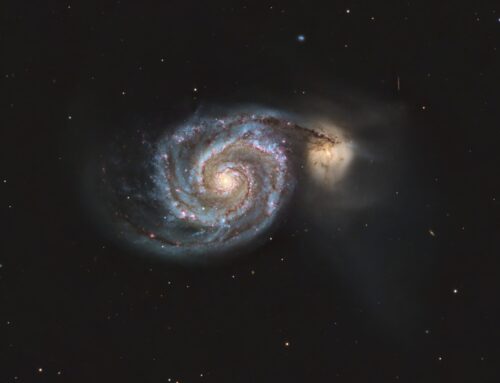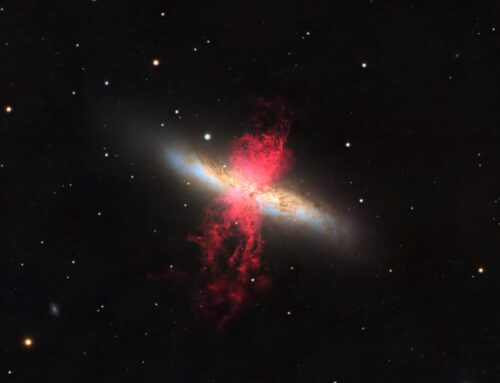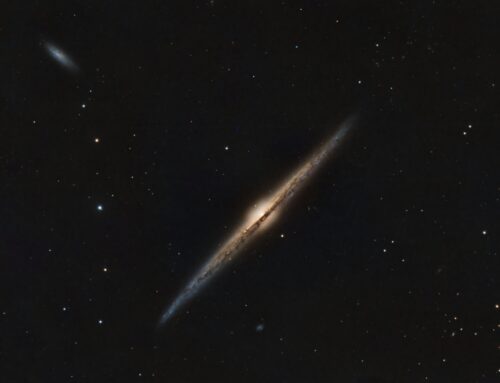NGC 4725
 Click image for full size version
Click image for full size version
June 28, 2021
NGC 4725 is the large galaxy in the centre of the image. It appears to have only one main spiral arm; this is due to distortion caused by interactions with other galaxies. NGC 4275 lies about 40 million light years away and is the largest member of the Coma I galaxy group. It is flanked by NGC 4712 to the right, and NGC 4747 near top left. Many other distant galaxies litter the field. I prepared an annotated image that identifies some of them.
This one of the first images made using my new QHY600M camera on my Sky-Watcher Esprit 150 f/7 refractor.
Tekkies:
Acquisition, focusing, and control of Paramount MX mount with N.I.N.A., TheSkyX and PHD2. Focus with Optec DirectSync motor and controller. Equipment control with PrimaLuce Labs Eagle 3 Pro computer. All pre-processing and processing in PixInsight. Acquired from my SkyShed in Guelph. Average transparency and seeing. Data acquired May 10-13, 2021 in a nearly moonless sky.
Luminance: Sky-Watcher Esprit 150 f/7 refractor and QHY600M camera with Optolong UV/IR filter
Chrominance: Takahashi FSQ-106 ED IV @ f/5 and QHY367C Pro one-shot colour camera with Optolong UV/IR filter
43x5m chrominance = 3hr35m
Total: 5hr40m
Data Reduction and Initial Processing
Preprocessing: The WeightedBatchPreProcessing script was used to create a Luminance master frame from the mono camera and an RGB master frame from the one-shot colour camera. The RGB master was registered to the Luminance master using StarAlignment.
Gradient Removal: DBE was applied to both masters using Subtraction.
Colour
Colour Balancing: Colour was balanced with ColorCalibration.
Linear Noise Reduction: MultiscaleLinearTransform was used to reduce noise in the background areas, using an internal mask to protect bright structures. Layer settings for threshold and strength: Layer 1: 5.0 0.85, 2 iterations; Layer 2: 3.5, 0.75, 2 iterations.
Stretching: HistogramTransformation was applied to make a pleasing, bright image, with background set to an intensity of approximately 0.10.
Lightness
Deconvolution: A star mask was made from the Luminance master to use as a Local Deringing Support Image. A copy of the image was stretched to use as a range mask. Deconvolution was applied (100 iterations, regularized Richardson-Lucy, external PSF made using the PSFImage script; Global dark deringing = 0.03).
Linear Noise Reduction: MultiscaleLinearTransform was used to reduce noise in the background areas, using an internal mask to protect bright stars. Layer settings for threshold and strength: Layer 1: 3.0 0.85, 1 iterations; Layer 2: 2.0, 0.75, 2 iterations.
Stretching: HistogramTransformation was applied to make a pleasing, bright image, with background set to an intensity of approximately 0.10.
Combining Lightness and Colour Images
LRGB Combination: The lightness image was applied to the RGB image using LRGBCombination with default settings.
Additional Processing
Nonlinear Noise Reduction: TGVDenoise was used in L*a*b* mode to reduce noise with a mask used to target the background areas and protect the stars and galaxy (max. 1,000 iterations and convergence selected for both lightness and chrominance).
Contrast Enhancement: LocalHistogramEqualization was applied twice using an inverted star mask to protect the stars, first with a scale of 40 (max contrast 1.5, strength 0.25, 1 iteration), followed by a scale of 130 (max contrast 1.5, strength 0.35, 1 iteration).
Sharpening: MultiscaleLinearTransform was used to sharpen Layers 2 and 3 with strengths of 0.1 and 0.08, respectively. A mask was used to protect background and stars and limit sharpening to the brighter galaxy features.
Final Steps: Background, galaxy and star brightness, contrast, and colour saturation were adjusted in several iterations using CurvesTransformation with masks as required. MorphologicalTransformation was used in Morphological Selection mode (Strength 0.5; Selection 0.11) through a star mask to shrink the brightest stars. ICCProfileTransformation (sRGB IEC61966-2.1; Relative Colorimetric with black point compensation) was applied prior to saving in jpg format.






I want to be Ron when I grow up. Too bad I’m already retired. NICE IMAGE!!